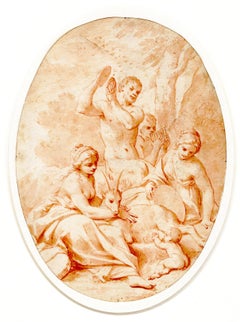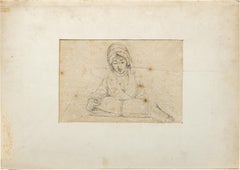Luigi Quaini Art
to
1
Overall Width
to
Overall Height
to
1
1
1
1
9,478
2,687
1,375
1,358
1
Artist: Luigi Quaini
The Infant Jupiter Nursing from the She-Goat Amaltheia (The Birth of Jupiter)
By Luigi Quaini
Located in Fairlawn, OH
The Infant Jupiter Nursing from the She-Goat Amaltheia
(The Birth of Jupiter)
Red chalk and wash on off-white paper, c. 1700
Unsigned
Attribuuted to Quaini by Dwight Miller, the sch...
Category
18th Century and Earlier Baroque Luigi Quaini Art
Materials
Chalk
Related Items
Italian School, Nicolo Grassi, 18th, Worship of Venus, The Venus Sacrifice, Amor
Located in Greven, DE
Italian School, 18th Century, Circle of Grassi,
This old master drawing is drawn in the late-Baroque or Rococo style.
It depicts a woman worshipping Venus/ preparing a sacrifice for ...
Category
Late 17th Century Baroque Luigi Quaini Art
Materials
Handmade Paper
$1,626 Sale Price
40% Off
H 8.9 in W 7.37 in
Antique Italian artist - 18th/19th century figure drawing - The writer
Located in Varmo, IT
Italian artist (18th-19th century) - Study for a writer.
17 x 25.5 cm, with passe-partout.
Pencil drawing on paper, without frame.
- Work signed indistinctly lower left (under pas...
Category
Late 18th Century Baroque Luigi Quaini Art
Materials
Paper, Pencil
$236 Sale Price
50% Off
H 6.7 in W 10.04 in
Part of the ring-wall of the Taj Mahal, Agra, India, 1914
Located in Amsterdam, NL
Part of the ring-wall of the Taj Mahal, Agra, India, 1914
Signed with initials and dated bottom right
Black chalk on paper, 45.5 x 53 cm
Literature:
Ernst Braches en J.F. Heijbro...
Category
1910s Art Nouveau Luigi Quaini Art
Materials
Paper, Chalk
$22,635
H 17.92 in W 20.87 in D 1.19 in
Old Master French Sanguine Drawing of Hercules
Located in Pasadena, CA
Old Master, French School red chalk drawing on paper is not signed .
Done in Sanguine on paper the nude appear like Hercule . The feel and look of the works while academic studies a...
Category
17th Century Baroque Luigi Quaini Art
Materials
Archival Paper
Antique Italian artist - 18th/19th century figure drawing - St. Sebastian
Located in Varmo, IT
Italian artist (18th-19th century) - Study for a St. Sebastian.
28 x 22 cm. 50 x 35 cm with passepartout.
Ink and pencil drawing on paper, without frame (not signed).
Condition re...
Category
Late 18th Century Baroque Luigi Quaini Art
Materials
Paper, Pencil
$590 Sale Price
37% Off
H 19.69 in W 13.78 in
Male Torso
By John Koch
Located in London, GB
Pencil, coloured pencil and chalk on paper, titled (lower left), signed (lower right), 31cm x 46cm, (51cm x 68cm framed).
John Koch was an American painter and teacher, and an impo...
Category
1950s American Modern Luigi Quaini Art
Materials
Paper, Chalk, Pencil, Color Pencil
Old Master Drawing, Baroque, Jacob de Wit, Allegory of Victory, Putti, Ships
By Jacob De Wit
Located in Greven, DE
Two putti with symbols of war and victory (cannons, cannonballs, armour, anchor, lion's head, laurel branch/ olive branch, flag, staff with helmet) in pediment triangle.
Probably a design for a painting or architecture
Pen-and-ink drawing in black on brownish paper, black wash
Plain gold moulding with UV glass
Allegory of Victory, 18th Century, Old Master Drawing, By De Wit, Figurative
Jacob de Wit...
Category
Late 17th Century Baroque Luigi Quaini Art
Materials
Paper, Crayon
$2,145 Sale Price
35% Off
H 8 in W 12.8 in
Fenzoni, Painting AND preparatorial Drawing, John the Baptist, Italy Renaissance
By Ferrau Fenzoni
Located in Greven, DE
The painting and the preparatory drawing are offered together.
Provenance
Private collection, Germany, Trier, c. 1980- 2013
Saint John the Baptist
Brown ink and wash over red chalk on oatmeal paper
31 x 20.5 cm
Inscribed: „Ferrau Fenzonio da Faenza invt. esque … imp. da Fran. Villamena …“.
bears the collector's mark of Henry Scipio Reitlinger (1882-1950; Lugt 2274a) on a tiny label glued to the verso
On the reverse is a partial drawing of a Pieta, pricked for transfer.
Provenance
New York, Doyle, 14. October 2015, No. 6
The painting and the preparatory drawing resemble the composition of an engraving after Ferraù Fenzoni by Francesco Villamena. Drawing, engraving and painting are almost identical, except for minor differences. Even the measurements nearly correspond: painting (32 x 25,5 cm), drawing (30 x 20,5 cm), engraving (31,1 x 23,5 cm).
Dr. Guiseppe Scavizzi confirmed the attribution of the present panting to Fenzoni and he dates it to c. 1590.
The inscription on the drawing reads “Ferrau Fenzonio da Faenza invt. esque. . . imp. da Fran: Villamena . . .”. The engraving’s inscription also lists place and date “Ferra Fensionius inventor/F. Villamoena sculpsit Rome/Aspectu fruitur… antra puer/cum Privilegio… 1613”.
Interestingly, the engraving is not mirrored as it is in most printing processes. Painting, drawing and engraving are not reversed but the same. It is remarkable to note that there are further paintings by Fenzoni which were engraved in the same order and not reverted. They also show strong parallels regarding the compositions and the measurements (see for example “Deposition of Christ” ).
Ferraù Fenzoni was an Italian painter mainly active in Todi. He is also called Il Faenzone after his birthplace (Faenza). He apprenticed in Rome during the papacy of Gregory XIII and contributed to numerous fresco cycles under pope Sixtus V, such as the Loggia della Benedizioni in the Lateran Palace, the frescoes on the walls and vaults of the Scala Santa of the adjacent Basilica of San Giovanni in Laterano, and the decoration in the Sistine library. His expressive canvases straddle the styles of Mannerism and Baroque. In 1594, he moved to Todi. A “Last Judgement” by him is housed in the cathedral of Todi. He returned to Faenza in 1599, where he decorated chapels in the cathedral from 1612 to 1616. In 1622, he completed a “Deposition”, now in the local Pinacoteca. In 1640, Fenzoni was named “cavaliere dello speron d’oro” by Cardinal Colonna and, on 25th April 1634, he was nominated vicar and “castellano of Granarolo”.
Fenzoni‘s style is characterized by a mixture of the Mannerism of the Northern Netherlands and the Italian Baroque.
Saint John the Baptist, Old Master, 17th Century, By Fenzoni, Religious Scene, Rome Art...
Category
16th Century Mannerist Luigi Quaini Art
Materials
Canvas, Oil, Handmade Paper
Ferrau FenzoniFenzoni, Painting AND preparatorial Drawing, John the Baptist, Italy Renaissance, 1590
$28,328 Sale Price
25% Off
H 12.21 in W 8.08 in
Studies for the Judgment of Solomon, a double-sided drawing by Simone Cantarini
Located in PARIS, FR
In this double-sided red chalk study, Simone Cantarini offers us a double reflection on the theme of the Judgment of Solomon. This sheet reveals his precise style and his sense of de...
Category
1640s Old Masters Luigi Quaini Art
Materials
Chalk, Laid Paper
Study for a Hunting Scene, a red chalk sketch attributed to Karel du Jardin
Located in PARIS, FR
We would like to thank Carolina Trupiano Kowalczyk for suggesting this attribution to Karel du Jardin after direct examination of the artwork. Her study of the drawing (in Italian), ...
Category
1650s Old Masters Luigi Quaini Art
Materials
Chalk, Ink, Laid Paper
$15,934
H 12.63 in W 15.5 in
A Study for the Angel of Saint-Severin church in Paris, by Paul Flandrin
Located in PARIS, FR
After the restoration of the Saint-John chapel’s frescoes at the Saint-Severin church in Paris in 2022, the drawing presented here is a moving testimony to their creative process. It...
Category
1840s Old Masters Luigi Quaini Art
Materials
Chalk
$4,131
H 15 in W 11.38 in
Portrait of a Man’s Head
By William Etty
Located in London, GB
Charcoal and white chalk highlight on paper
Label of J.M Maas Gallery (verso)
36cm × 28cm (54cm × 43cm framed)
Etty, a student of Thomas Lawrence, R.A., was the first significant Br...
Category
19th Century English School Luigi Quaini Art
Materials
Paper, Chalk, Charcoal
Luigi Quaini art for sale on 1stDibs.
Find a wide variety of authentic Luigi Quaini art available for sale on 1stDibs. If you’re browsing the collection of art to introduce a pop of color in a neutral corner of your living room or bedroom, you can find work that includes elements of orange and other colors. You can also browse by medium to find art by Luigi Quaini in chalk and more. Not every interior allows for large Luigi Quaini art, so small editions measuring 7 inches across are available. Luigi Quaini art prices can differ depending upon medium, time period and other attributes. On 1stDibs, the price for these items starts at $4,500 and tops out at $4,500, while the average work can sell for $4,500.

